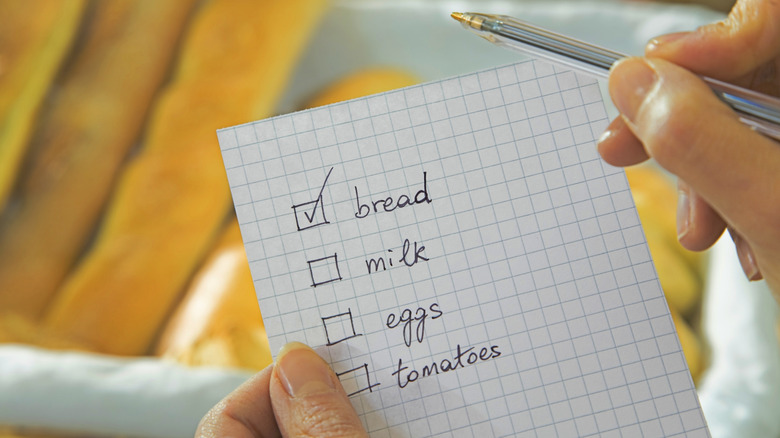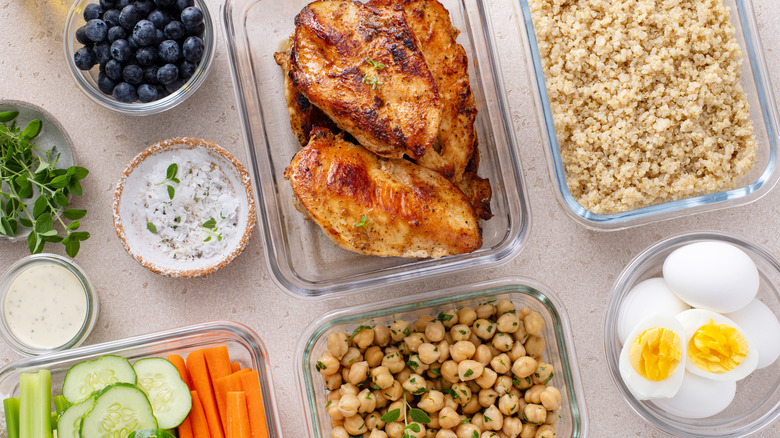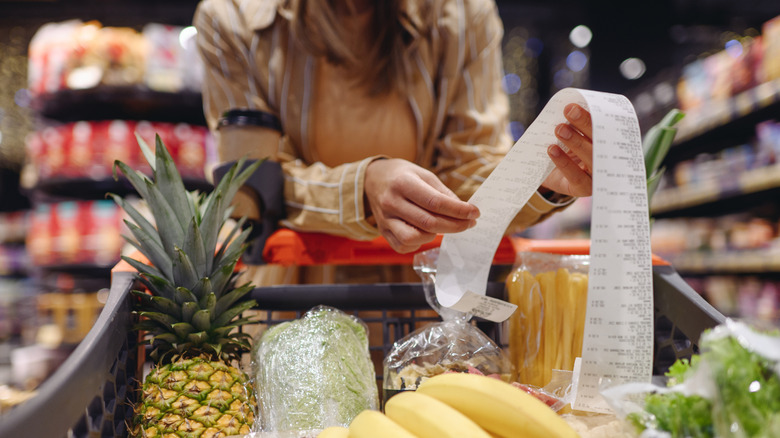5 Tips For Making A Better Grocery Store List
Writing a grocery list may seem like a simple task, but making a good one is deceptively complex. The best approach will include much more than just jotting down a list of things to buy. Additional considerations can help you create the best list possible.
For starters, think of why you're buying each item. Begin with a list of meals you plan to cook, then use that to populate a grocery list with components you need. Consider adding alternatives to ingredients you know the store may not have so you aren't thrown off course if something is sold out. Also, track your costs while writing the list so you aren't surprised by a huge bill at the end of your trip.
Grocery shopping pros who are familiar with their preferred store can even organize their grocery list based on where each item is, minimizing backtracking through the aisles. And finally, list perishables last to keep them in the cold longer.
Start with a list of meals
One of the things professional chefs never do when grocery shopping is leave the house without an organized list. Planning meals ahead of time gives you a framework around which to build a well-written grocery list. Compare the required ingredients for each recipe against the staples you have on hand to determine what you actually need to buy.
To make the most of your purchases, plan meals that use versatile ingredients. You can even use multipurpose items like eggs, rice, and bread to create a huge range of dishes without necessarily buying a ton of separate items.
You can also make this step easier by keeping a running list of what's already in your pantry or refrigerator — this is known as a reverse grocery list, which can also save you precious time. Taking regular inventory of the items you already have makes it easier to determine what you need to complete any given recipe.
Add replacement items and make contingency plans
We've all been there: You're shopping for a specific ingredient in a recipe, and the store is sold out. Rather than fumbling with your phone in the middle of the grocery aisle to figure out what to buy instead, we recommend anticipating these substitutions when you're writing out your grocery list.
Picking replacements is one of the must-have tips for ordering groceries online, but it's also a helpful timesaver for shopping in person. For instance, heavy cream is a keystone ingredient with many convenient substitutions, like sour cream or milk combined with butter.
Research the world of surprising substitutions — like swapping out baking powder for yogurt in baked goods — so that one way or another, you'll always be able to get what you need from the store. Planning ahead makes ingredient swaps like these easy to do on the fly, particularly if your grocery store is frequently out of certain items.
Consider your costs
Nobody likes paying $50 more for their groceries than they intended. This is why the list-making stage is a great opportunity to check how much money you're going to spend and to adjust shopping plans as needed to stay on budget.
Napkin math with rough price estimates should be enough to corral your grocery spending. Those who desire accountant-level detail, however, can use their old receipts to develop a spreadsheet containing items' exact prices, which they can then turn into infinite grocery lists. You can also compose your list in conjunction with grocery shopping apps that offer points or cash back, like Ibotta and Rakuten, focusing on items that will also earn you a bit of money.
It's easy for a grocery list to rack up a high estimated total, though, which is why it's important to consider where you're spending more money at the grocery store than you need to. Tips like using seasonal produce and seeking out quality generic brands can help you stretch your dollar in the planning stage.
Arrange your list based on each item's in-store location
You may have noticed over the years that many grocery stores have similar layouts. This is no coincidence — stores can use their floor plans to increase customer spending. Think of bakeries that are located near the store entrance to prime you with appetizing smells, or the temptation of small treats like soda and candy in the checkout lanes, all while your money is literally in hand.
Fortunately, the vague familiarity of many grocery stores can also make you a more efficient shopper. Armed with this knowledge, you can use your list to inform your grocery store path. For instance, fresh items are usually around a store's perimeter, so if your list only contains fresh foods, you can easily avoid the temptation of the center aisles.
Even if your shopping trip does take you through the whole store, a well-organized list based on your items' locations can help you chart the most efficient route. This minimizes backtracking, cuts time spent shopping, and reduces opportunities for impulse purchases.
Pick up perishables last
It doesn't make much sense to start a grocery run with ice cream. Beyond the obvious peril of frozen treats melting, however, some groceries might also become dangerous if left unrefrigerated for too long. For quality and safety reasons, consider putting perishables at the end of your grocery list so you pick them up last.
According to general food-safety guidelines, refrigerated items can be left out for a maximum of two hours before they're subject to unsafe levels of bacterial growth. Critically, this includes the time groceries spend in your shopping cart, at checkout, and on the journey home. If temperatures exceed 90 degrees Fahrenheit, you only have one unrefrigerated hour before the food must be discarded.
This may seem like plenty of time without planning, and depending on your circumstance, it might be. But a big shopping trip with long register lines and a congested commute home might leave you uncomfortably close to a throwout point. Buy yourself more time by listing cold items last and picking them up at the end of your trip.





